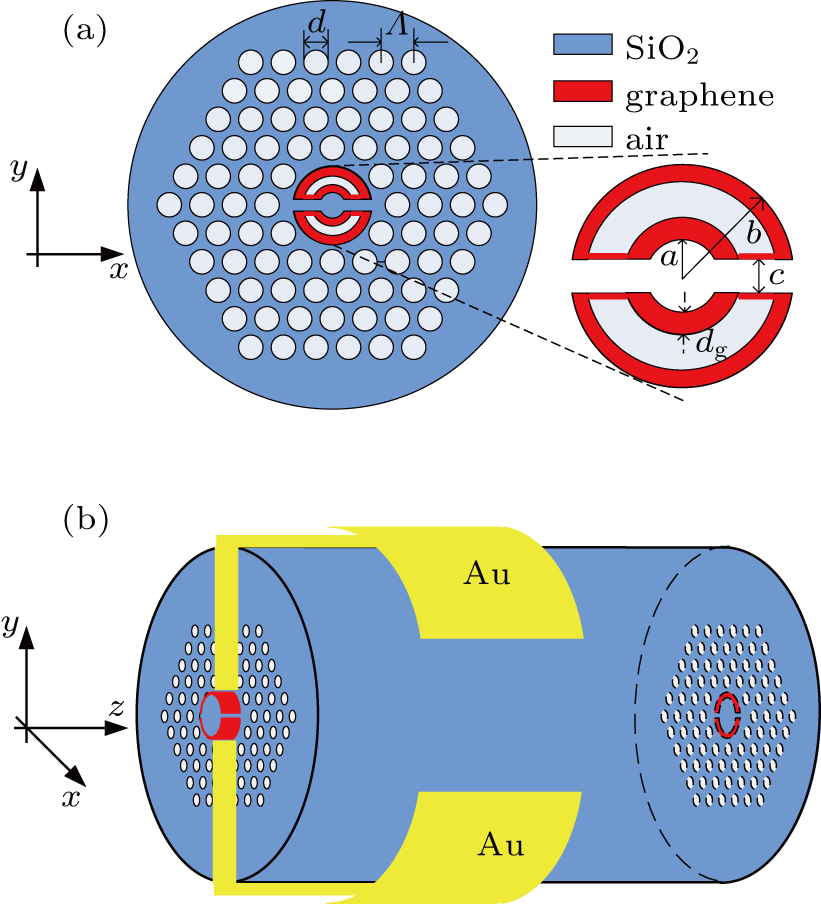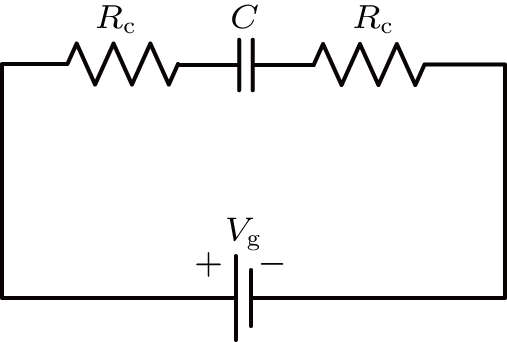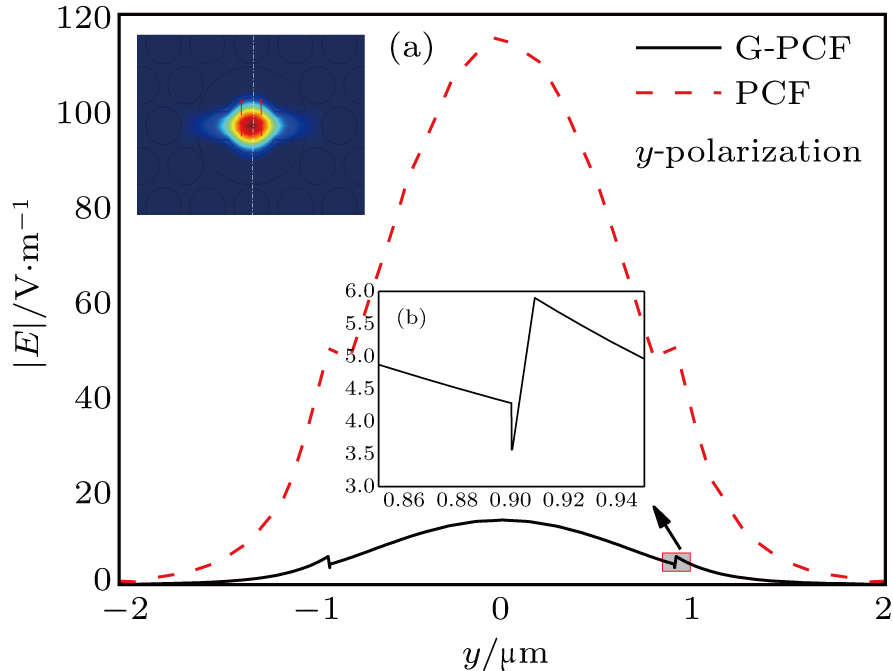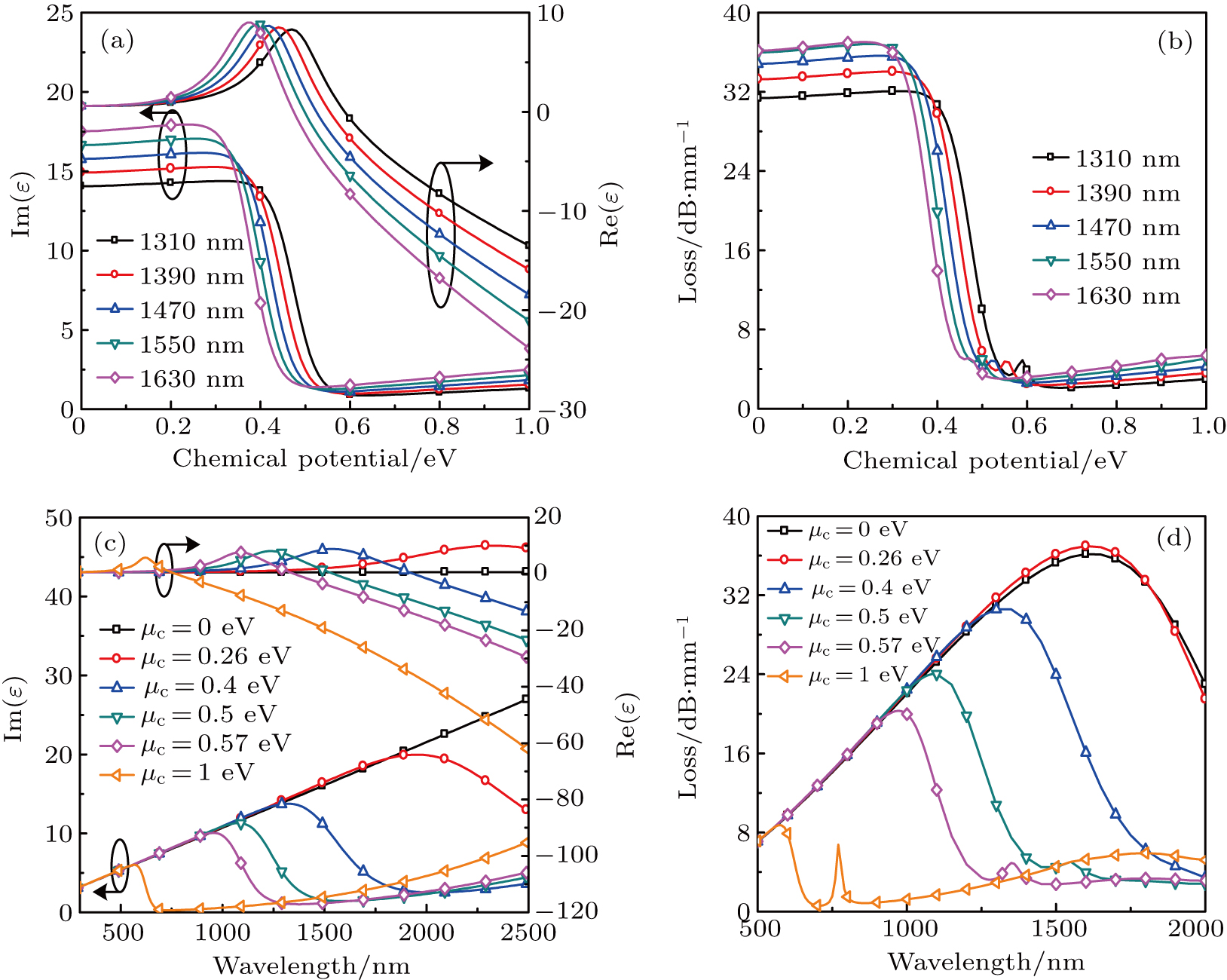† Corresponding author. E-mail:
A compact electro-absorption modulator based on graphene photonic crystal fiber is proposed. To enhance the graphene–light interaction efficiency, the innermost six air-holes of photonic crystal fiber are replaced by two large semicircular holes, and monolayer graphene is deposited on the two large semicircular holes. By optimizing the structure parameters, a strong graphene–light interaction is obtained. Moreover, the switch on–off point of the modulator is unchangeable, which is only related to the frequency of the incident light. The influence factors of this composite structure have been analyzed. The proposed modulator is compared with other graphene-based modulators, and the results show that it is filled without dielectric spacer. There are some excellent performances, such as an extinction ratio 7 dB of y-polarization mode, 3-dB modulation bandwidth of 70 GHz with small footprint of 205 μm, and a consumption of energy per bit 59 pJ/bit.
Optic modulator is a critical component in the optical fiber communication network, and its characteristics will directly affect the performance of transmission network. Graphene-based optic modulators have received extensive attention with the advent of graphene. At present, electro–optical modulator and all-optical modulator are mainly studied. All-optical modulator, a nonlinear optical process (such as two-photon absorption, saturable absorption, or nonlinear refraction) is required to realize control of light by light.[1] However, electro–optic modulations are easy to control and the materials are easy to access. In electro–optic modulation, the complex refractive index of materials will change due to the electro–optic effect when they are subjected to an external electric field, such as modulators based on semiconductor or LiNbO3,[2] but they suffer from a narrow operating bandwidth, which limits their further applications. Thereby a graphene-based electro–optic modulator (EOM) is proposed.
Graphene is a two-dimensional material formed by a single sheet of carbon atoms with a hexagonal lattice, which was found in 2004.[3] It has attracted enormous interests because of its unique electronic and optical properties, such as high carrier mobility,[4] absorption over a wide spectral range from visible to infrared.[5] Moreover, graphene is considered to be a perfect atomic monolayer with a rather unique band structure that the valence band and the conduction band touch each other at six points, which are called as the Diract points. The unique zero-gap bandstructure makes absorption in graphene easily controlled through doping or electrical gating by shifting the Femi level.[6–8] Those features above imply that graphene can be an appropriate candidate to be used as the active medium in electro–optical modulators. Recently the silicon waveguides and side-polished fibers integrated graphene-based electro–optic modulators have been demonstrated.[9–14] Compared with conventional modulators, EOM based on graphene has advantages of wide modulated bandwidth, low bias voltage, and small footprint. However, the waveguide integrated modulators suffer from high insertion loss, complex manufacturing process, which limit their applications in practice. Moreover, additional components in the fiber systems will increase optical transmission loss and system complexity. Besides, the side-polished fiber could destroy the structure of the optical fiber, resulting in additional energy loss via scattering effect, and the exposed core is easily affected by the ambient environment. To overcome above mentioned difficulties, photonic crystal fiber (PCF) can be used for EOM. PCF has the advantages of design flexibility, high confinement, controllable birefringence, etc.[15] Many functional devices based on PCF and graphene have attracted increasing attention, such as splitters,[16] all fiber laser,[17] refractive index sensor,[18] and so on. The performances of modulators based on PCF can be further promoted by growing uniform and large area graphene sheet into air holes. Direct graphene growth on silicon dioxide substrate by chemical vapor deposition (CVD) has been demonstrated.[19,20] In this way, graphene can be placing into the air holes of fiber instead of the chemical transfer method. The efficiency of electro–optic modulator can be enhanced by using PCF with additional electrodes to the optical fiber.
Taking the mentioned advantages of graphene and PCF, a compact electro-absorption modulator based on graphene photonic crystal fiber (G-PCF) is proposed. In order to enhance the light–matter interaction, the proposed PCF has two large semicircular holes, and a monolayer graphene is deposited on the curved holes in the center. In particular, the geometric parameters of PCF, the chemical potential of the graphene, and the frequency of the incident light related to the fundamental mode are investigated in detail using a two-dimensional finite element method (FEM). By optimizing these parameters, the electro-absorption modulator can reach to an extinction ratio of 7 dB in y-polarization mode, 3-dB modulation bandwidth of 70 GHz with small footprint of 205 μm, and a consumption of energy per bit of 59 pJ/bit.
The proposed structure of the G-PCF is illustrated in Fig.
In Fig.
In the structure of Fig.
Based on the device structure in Fig.



The energy per bit refers to energy consumed by the modulator switch every time, which is depends on the capacitance C of the structure and voltage ΔV between on and off states of the modulator. The energy per bit is defined as

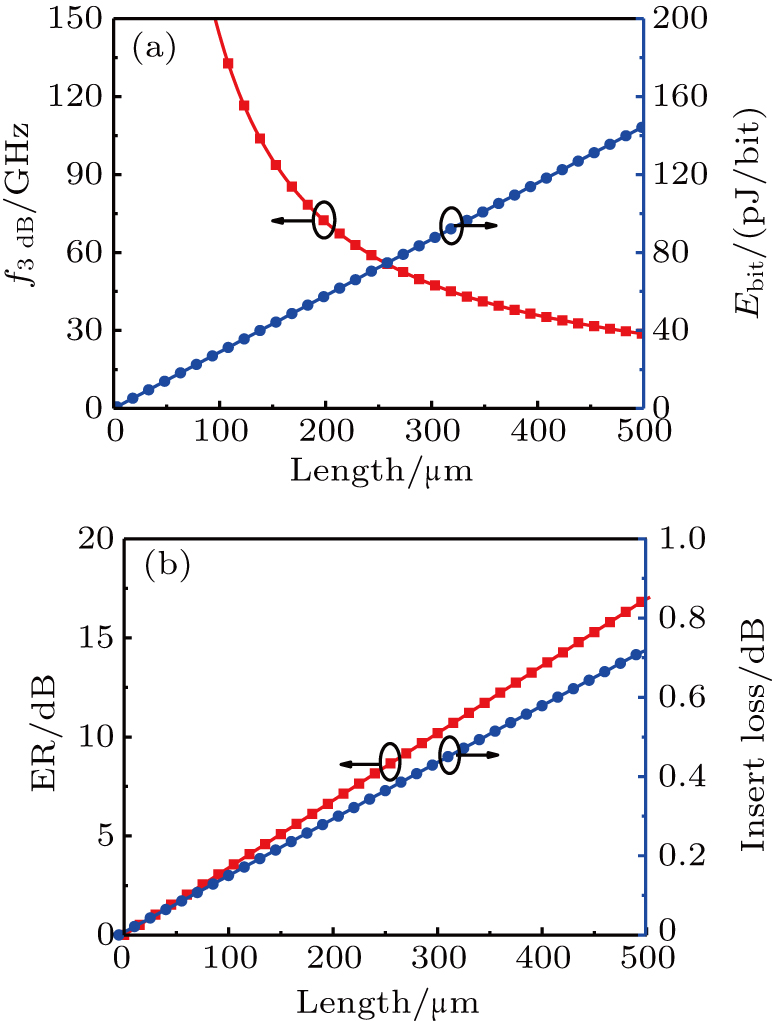 | Fig. 3. (a) The 3-dB modulation bandwidth and energy per bit versus the length of active region, (b) extinction ratio and insert loss versus the length of active region. |
From the relationship between the external modulation voltage and the chemical potential of graphene in formula (
Although the optimization of semicircular holes could reduce the voltage value, the silica in the fiber center is medium for light transmission, reducing its size will affect the transmission. Thereby, the size of the modulator selected is a = 0.66 μm, b = 1.9 μm, c = 0.6 μm, and larger voltage is needed to achieve the modulation effect, because the thickness of silicon dioxide is in the order of micron, its switch on and off voltages are 298 V and 62 V, respectively.
Due to the unique bandstructure of graphene, the interband absorption and intraband absorption should be considered, which can be evaluated from the Kubo formula[26] as follows:



Then the graphene’s permittivity can be evaluated as

According to Maxwell’s equations, when spatial permeability μr ≈ 1, the relationship between permittivity and refractive index is as follows:

 | Fig. 5. The graphene characters under different chemical potentials: (a) permittivity and (b) refractive index. |
The real part of the permittivity Re(ε) firstly increases, then decreases with the chemical potential increasing. The imaginary part of the permittivity Im(ε) is almost constant from 0 eV to 0.3 eV, then decreases rapidly when the chemical potential is within the range of 0.3–0.5 eV. At the chemical potential μc = 0.5 eV, the Re(ε) changes from positive to negative (Fig.
The mode field distribution of PCF after adding the graphene has been analyzed when the incident wavelength is 1550 nm. To evaluate the light absorption passed through the graphene film, the electric field distribution of y-polarization mode before and after graphene deposited along the y axis is analyzed as shown in Fig.
In Fig.
 | Fig. 7. Re(neff) and Im(neff) of x-polarization and y-polarization modes under different chemical potentials. |
In Fig.
 | Fig. 8. The corresponding loss versus chemical potential and the electric field profile (the inset of the figure). |
In Fig.
The structural parameters of the optical fiber have great influence on the transmission of light field. Figure
In Fig.

When graphene is bound into an optical waveguide, the effective refractive index shows a linear relationship with the permittivity of graphene. fg determines the change of effective refractive index.[27] So the change of effective refractive index and permittivity of graphene with chemical potential is almost the same. fg changes near the ENZ point dramatically, which causes a small fluctuation in Im(neff). So there is a small peak around 0.5 eV in Fig.
As shown in Fig.
 | Fig. 10. The loss difference of G-PCF versus inner radius for different semicircular hole’s distance. |
In Fig.
Previous studies have been performed the permittivity also varies with the different wavelengths at 1550 nm, since graphene’s conductivity is related to the optical wavelength as shown in Fig.
As shown in Figs.
To evaluate the operating wavelength of the modulator, the wavelength was studied at different chemical potentials in Figs.
In summary, we have proposed a compact electro-absorption modulator based on graphene photonic crystal fiber. The performance of the device is investigated by theoretical simulation on the basis of the controllable electric properties of graphene Fermi level. Simulation results shows that the electric field distribution decreases sharply in G-PCF in terms of electrons absorption by graphene, and switch on–off point of modulator is only related to the frequency of incident light. Geometric parameters of PCF could significantly change the effective mode index of fundamental mode and losses. By optimizing these parameters, the electro-absorption modulator can achieve some good characters including an extinction ratio 7 dB of y-polarization mode, 3-dB modulation bandwidth of 70 GHz with small footprint of 205 μm, and a consumption of energy per bit 59 pJ/bit. This modulator can work over a wide wavelength range from 1250 nm to 1900 nm.
| [1] | |
| [2] | |
| [3] | |
| [4] | |
| [5] | |
| [6] | |
| [7] | |
| [8] | |
| [9] | |
| [10] | |
| [11] | |
| [12] | |
| [13] | |
| [14] | |
| [15] | |
| [16] | |
| [17] | |
| [18] | |
| [19] | |
| [20] | |
| [21] | |
| [22] | |
| [23] | |
| [24] | |
| [25] | |
| [26] | |
| [27] |


